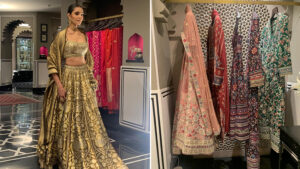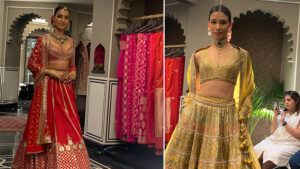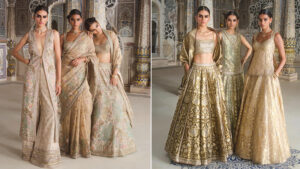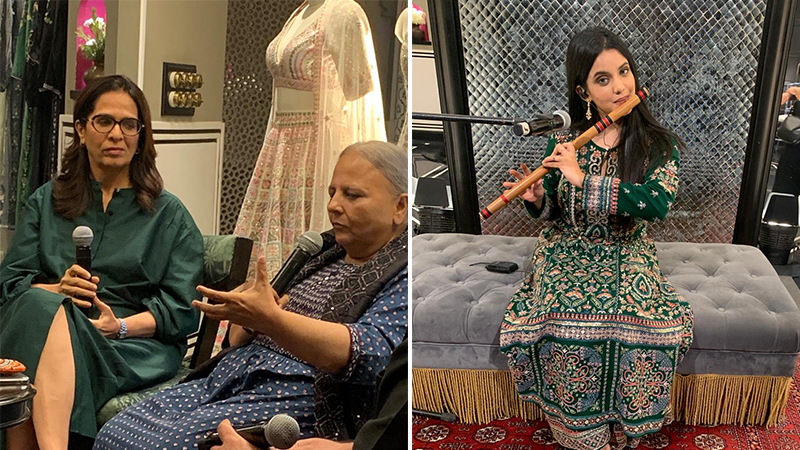I have always felt fashion is a mood, and if that is anything to go by, couturier Anita Dongre knows how to get you into a good one. She decided to show her bridal collection at her Mehrauli store in South Delhi, at a no-fuss intimate gathering. Generally, couture shows are meant to be larger-than-life; Dongre kept it subtle, even as the fragrance of mogras filled the air complementing young flautist Siddhi’s (daughter of three times Grammy-nominated Ajay Prasanna) melodious notes.
The store has the feel of an opulent Rajasthani palace, nestled in the dusty terrain, emboldened with imposing architecture, its surreal arches and paintings taking us back in time. Anita has an elephant as her logo, it was only natural she would tie up with an NGO that matched with her ethos. The Ahmedabad-based NGO, SEWA (Self-Employed Women’s Association), started by Gandhian Ela Bhatt and now run by Reema Nanavaty, was the highlight of my evening. Nanavaty, an IAS officer, quit the service in a year to join SEWA full-time, in 1985, to assist 2.9 million artisans in Gujarat and other States achieve sustenance through craft. She handles 4,813 self-help groups, 160 co-operatives and 15 economic federations across India and seven South Asian countries. SEWA’s food security program has one million households, and it provides women access to renewable energy. In 2013, she won the Padma Shri.
Nanavaty, also a member of the Advisory Council on Gender of the World Bank Group, exclaims, craft is in the DNA of rural women, whether it is carpet, ikkat, grass weaving, or bangle making. “We are a skill-rich country. We have millions of artisans who now have a livelihood.”
“I started working with SEWA nine years ago,” says Dongre. Dongre’s son Yash, who pursued his master’s degree in international marketing from Hult Business School, Boston, is the one who took his mother to see the amazing work done by hand, which “bowled her over”.

Yash set up the Anita Dongre New York store in Broadway and heads the American operations from New York. “The learning process was tough for both us and the artisans. The first batch we gave them came back. My creative team mixed up different stitches without a clear understanding of how it works in SEWA. When you work with craft there are challenges. Why shouldn’t there be? Boundaries are good,” says Dongre, who has a store in Dubai (Dubai Mall) as well.
As the world is moving to slow fashion, SEWA is a champion of this philosophy. The support is so intense that now the second or third generation, who are armed with smartphones, do not take this as a hobby but a mode of serious income. “In a dry, desert area, an artisan takes care of the housework (feeds cattle, cooks and cleans) and then sits to embroider. Interestingly, now men serve the tea, as the woman is the breadwinner – economic security enables this,” says Nanavaty. “With the money, they have made pucca homes and acquired assets like pumps. Children are getting an education. The migration rate is down to 92% and the literacy rate that was 2% is now soaring. Due to frequent drought, women suffered, but with their skill they resuscitated their families, and Ramba Behn, a senior artisan, says, ‘lives of my families hang by the thread I embroider’,” adds Nanavaty.

Dongre has offered design interventions that are crucial for the survival of craft. “Reema told me that she didn’t know what was in fashion, so I gave them colours and trends; she gave us skill,” says Dongre.The girls in villages are passed on the skill from mothers, who begin to embroider as soon as a girl child is born, but by the time she is of marriageable age, they have at least 12 to 13 trousseau items ready. From their mattress to camel covers, everything is handmade; this skill brings joy to their lives. “This economic transformation is heartening and those who thought of this as a redundant skill have been proved wrong. Many daughters who are now engineers or nurses still embroider for dignity and respect,” says Nanavaty.
Dongre was opening her New York store when there were floods in Gujarat. The artisans respected her timing by finishing the orders and storing the clothes in a safe place for dispatch later. Dongre hopes she can spot a designer from one of these villages soon.
Fashion changes every week. The new generation is vigilant on quality and have devised their own system of selection process. Interestingly, till today, traditional motifs like parrots and peacocks are used. “They never know what they are embroidering will turn into — a lehenga, kaftans or a skirt, a choli… when they see a parrot embroidered on the sleeve, or a tiger on a pocket, it thrills them,” says Nanavaty.

Earlier, they used to work on coarse fabrics. Dongre introduced finer, fluidones, even modal, and sent them swatches to practise on. “SEWA helped us enormously, conducted quality checks, got artisans together, and delivered on time. More designers should work with NGOs,” says Dongre, adding they still use six stroke and eight stroke looms.
The beauty of this craft is they work with glass mirrors that are hand-cut. They grow cotton, spin, and then embroider on it – the entire process is
done at home. “Craft is community-specific, it is their identity, and they are proud of it,” concludes Dongre. – Asmita is the Lifestyle Editor of NRI Focus. She is an award winning journalist who has been writing on fashion for the last 32 years


Leave a Reply